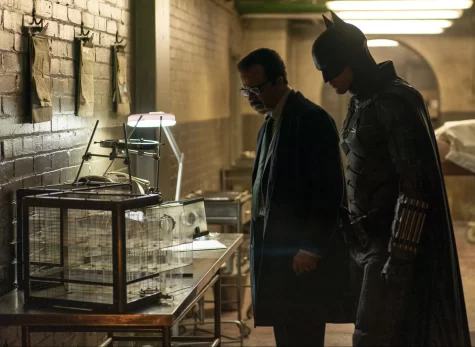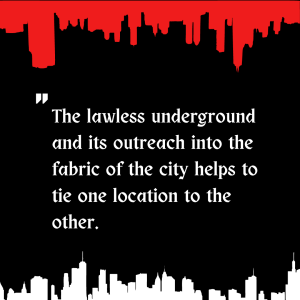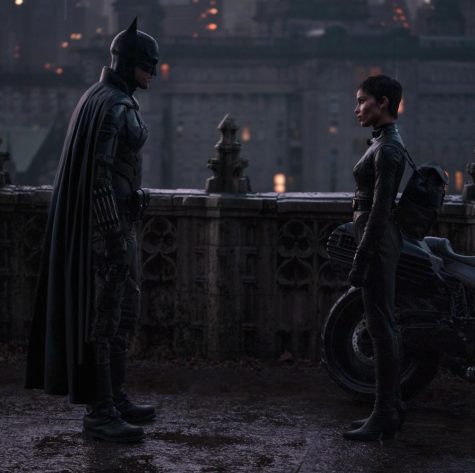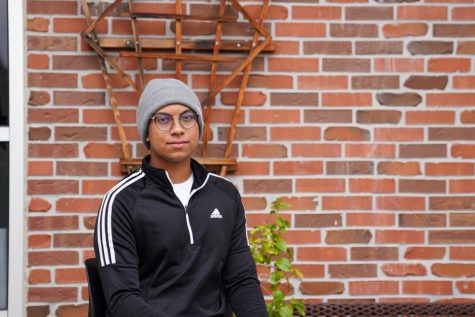‘The Batman’ is a nuanced take on a classic character
A refreshed iteration of the caped crusader exhilarates
Warner Bros. Entertainment Inc.
The Batman investigates a crime scene and searches for clues. Photo | Warner Bros.
March 11, 2022
As the bat-signal looms over a Halloween night, “The Batman” plunges audiences into Gotham City’s underbelly. Directed by Matt Reeves and starring Robert Pattinson and Zoë Kravitz, the film released theatrically on March 4.

The premise is a familiar one — with crime festering in Gotham City, billionaire Bruce Wayne (played by Robert Pattinson) instills fear into the city and keeps criminals in check through his secret vigilante persona, Batman. To solve his latest case, Batman teams up with cat burglar Selina Kyle (played by Zoë Kravitz) and police lieutenant James Gordon (played by Jeffrey Wright) to search for the Riddler (played by Paul Dano), a Zodiac-esque serial killer. As he gets closer to finding him, Batman realizes he and the Riddler are more alike than they seem.

World-building is what defines the film, with its bleak tone set from the get-go. Opening with a self-monologue from Batman and Nirvana’s “Something in the Way,” the film successfully encapsulates an emo-punk aesthetic that carries into the character designs, such as Wayne’s black eye makeup. Cinematography-wise, Gotham is characterized with precision by dimly-lit alleys, seedy nightclubs, and gothic rooftops. The power cycle-driven criminal network fleshes out each environment. Mobsters Carmine Falcone (played by John Turturro) and the Penguin (played by Colin Farrell) are shown to be in charge of the lawless underground and their outreach into the fabric of the city helps to tie one location to the other. This makes the film feel self-contained as Gotham’s layered underworld is captivating to the point where a change in location isn’t needed.
To ground the film in reality, action sequences are depicted as physically tasking through varied and lengthy choreography. A highway chase sequence where the Penguin attempts an escape from the Dark Knight is the cinematic highlight of the film. Throughout the scene, fixed camera angles provide audience members a chance to get their bearings during the fast-paced sequence and add to the immersion. Batman’s gadgetry is also tastefully limited to a grappling gun, taser and contact lenses that function as a camera in this iteration of the superhero, making the film seem more realistic.

With a nearly three hour-long runtime, the pacing of the film isn’t what most audiences would expect from a typical comic book movie. Instead, it’s more of a detective noir murder mystery. “The Batman” masterfully takes its time setting up Wayne’s motivations and ideology as the film questions the effectiveness of fear-based vigilantism. Even side characters such as Wayne’s butler and Falcone get detailed backstories and nuanced characterization, which makes almost all the characters in the film seem like they are antagonists.
However, the film is in a weird gray area where the runtime could be both longer — to expand on scenes briefly mentioned — or could be cut short to focus on concision. Even though the film goes into depth with side characters, it may distract audiences from the main plot. As a result, it disappoints some viewers, whether they are more interested in an action-packed thriller or a lengthy character study film.
At a time when cinematic universes dominate theater screens, “The Batman” is a refreshing and focused hero’s journey in which a small group of characters tackle personal issues while also digging into the corruption that threatens their city.
4.5/5





























